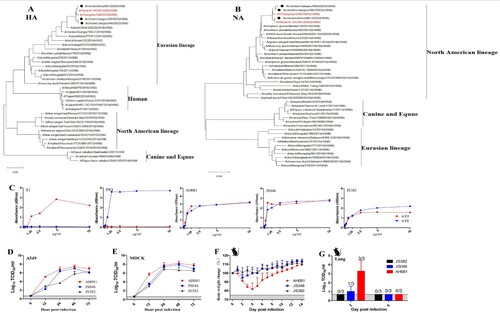Figures & data
Figure 1. Phylogenetic trees of hemagglutinin (A) and neuraminidase (B) genes of the novel three H3N8 AIVs isolated from chickens in China, 2022. The trees were generated by maximum likelihood with the MAGE X software. The viruses from this study were labeled in black circles, the H3N8 AIVs that caused human infections in China were marked in red. Scale bars indicate branch length based on number of nucleotide substitutions per site. (C) Receptor-binding properties of the H3N8 viruses. The receptor binding of the H3N8 viruses was determined using various concentrations of sialic acid conjugated to biotinylated sialylglycopolymers (3′SLN and 6′SLN) via direct solid-phase binding assays, A/Chicken/Jiangsu/X1/2004(H9N2) (X1) and A/PuertoRico/8/1934(H1N1) (PR8) were selected as α-2,3 receptor and α-2,6 receptor controls, respectively. Growth kinetics of the H3N8 viruses in MDCK and A549 cells. MDCK and A549 cells were infected with each virus at an MOI of 0.001 (D and E). Supernatant samples were collected at 6, 12, 24, 48 and 72 hpi, and viral titers were measured in MDCK and A549 cells, respectively. Pathogenicity of the three H3N8 viruses in mice. Five-week-old BALB/c mice were infected intranasally with 105 TCID50 units of each virus. Percentage of bodyweight change of mice infected with each virus (F). The viral titers of the lungs of the infected mice collected at 3 and 6 dpi were measured in MDCK cells (G).

